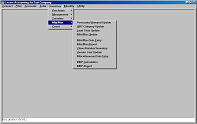
Automatically establish minimum and maximum stock levels.
Min and max define when stock is to be reordered and how much.
Levels are based on demand and lead time, both of which may be automatically or manually established for each product.
The goal is to minimize the investment in inventory while still providing close to 100% fill ratio.
Forecasted Demand Update

Use to calculate an estimated Demand for the next month. This demand figure will be subsequently used to calculate Min/Max stock levels.
User may select a range of products to update.
Report prints as update is occurring.
Optional feature, since the Min/Max may be manually input for any product.
Run-time options let the user select actual shipments, actual unit demand, or forecasted sales to make the calculation.
ABC Category Update

Use to update the ABC code for a group of products. The ABC code will then segregate the inventory in three priority groups so that maximum stock levels may be set differently for each group.
Run-time options let the user select the group breakdowns and whether to base groups on Sales or Profit.
Lead Time Update

Used to calculate the average lead time for a group of products. Accurate lead times are essential to calculating an accurate Min/Max stock level.
User may select a range of products to update.
Report prints as update is occurring.
Run-time options let the user select a number of incoming transactions to average and may increase the calculated average by a percentage.
Min/Max Update

Used to calculate the Minimum, Maximum, and Safety Stock levels for selected products.
User selects a range of products to update.
Report prints as update is occurring.
Run-time options let the user base calculations on the forecasted demand calculated above, or on the actual sales forecast for each product.
Min/Max Data Entry

All of the above fields that may be automatically calculated may also be manually entered using this program.
User selects data fields to be input from Demand, ABC, Lead, Minimum, Maximum, and Safety stock.
Products may be retrieved to the screen for data entry by entering the product number, or by pressing (RETURN) to automatically retrieve the next number.
The data input here overrides any automatic calculation.
Min/Max Report

Prints an inventory list highlighting the Minimum, Maximum, and Safety Stock levels for each product included.
Sort by Product number, class, vendor, or category.
Close Residual Inventory
Each product record contains a field for Book Value. When stock is added to or deducted from inventory, the transaction value is added to or deducted from the Book Value for that item. This book value corresponds to the amount in the General Ledger under the Inventory asset account.
The unit cost of each item is a moving average, calculated each time stock is added to inventory. The Value of an item, the unit cost multiplied by the quantity on hand, should always be equal to the Book Value, give or take a few pennies for rounding. Occasionally, due to negative on-hand situations or other errors, the Value and the Book Value are different. This causes the total of the Inventory Valuation Report (subsidiary ledger to the Inventory asset account) to be out-of-balance from the General Ledger. This residual value can be closed out, in a manner similar to closing the expense and revenue accounts. This program outputs a General Journal closing transaction with postings to Inventory and Cost of Goods Sold, and updates the product record so that the Book Value equals the calculated Value.
Material Requirements Calculations
Uses sales forecast and actual booked orders, lead times, and bills of materials to predict when and in what quantities, new material orders (either purchase orders or workorders) should be made.
Material Requirements Report
Prints the results of the Material Requirements Calculations.
Products can be sorted by Product Number, Class, Vendor, or Category. A range of products may be included.
Detail format shows a line for each transaction type that is used to calculate a requirement. The Summary format shows only the resulting requirement.